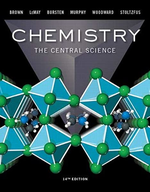?The following equilibria were measured at 823 K:\(\mathrm{CoO}(s)+\mathrm{H}_{2}(g)
Chapter 15, Problem 15.96(choose chapter or problem)
The following equilibria were measured at 823 K:
\(\mathrm{CoO}(s)+\mathrm{H}_{2}(g) \rightleftharpoons \mathrm{Co}(s)+\mathrm{H}_{2} \mathrm{O}(g) \quad K_{c}=67\)
\(\mathrm{H}_{2}(g)+\mathrm{CO}_{2}(g) \rightleftharpoons \mathrm{CO}(g)+\mathrm{H}_{2} \mathrm{O}(g) \quad K_{c}=0.14\)
(a) Use these equilibria to calculate the equilibrium constant, \(K_{c}\), for the reaction \(\operatorname{CoO}(s)+\operatorname{CO}(g) \rightleftharpoons \operatorname{Co}(s)\) \(+\mathrm{CO}_{2}(g)\) at 823 K.
(b) Based on your answer to part (a), would you say that carbon monoxide is a stronger or weaker reducing agent than \(\mathrm{H}_{2}\) at T = 823 K?
(c) If you were to place 5.00 g of CoO(s) in a sealed tube with a volume of 250 mL that contains CO(g) at a pressure of 1.00 atm and a temperature of 298 K, what is the concentration of the CO gas? Assume there is no reaction at this temperature and that the CO behaves as an ideal gas (you can neglect the volume of the solid).
(d) If the reaction vessel from part (c) is heated to 823 K and allowed to come to equilibrium, how much CoO(s) remains?
Text Transcription:
CoO(s)+H_2(g) \rightleftharpoons Co(s)+H_2 O(g) K_c=67
H_2(g)+CO_2(g) \rightleftharpoons CO(g)+H_2 O(g) K_c=0.14
K_c
CoO(s)+ CO(g) \rightleftharpoons Co(s) + CO2(g)
H2
Unfortunately, we don't have that question answered yet. But you can get it answered in just 5 hours by Logging in or Becoming a subscriber.
Becoming a subscriber
Or look for another answer
